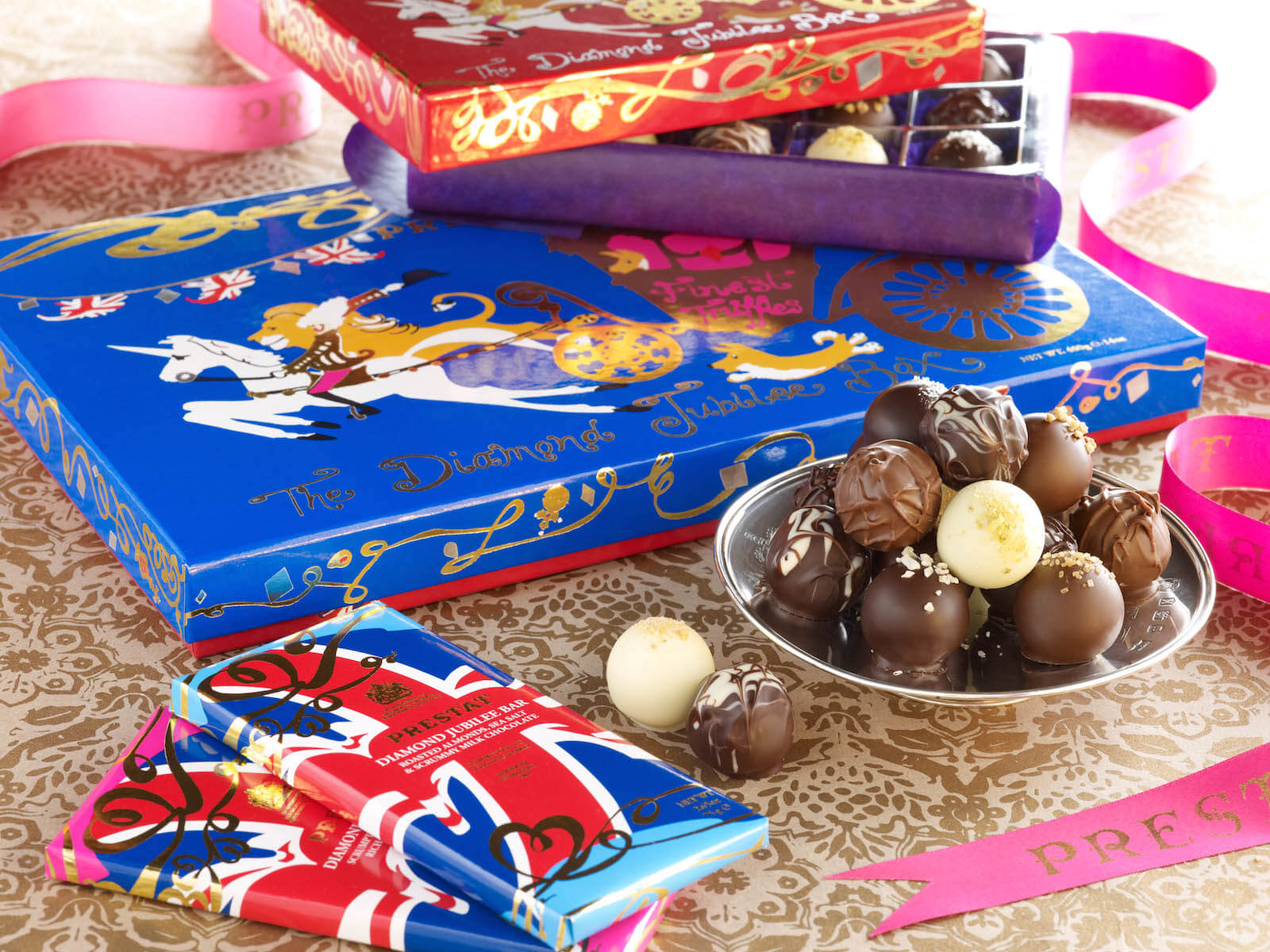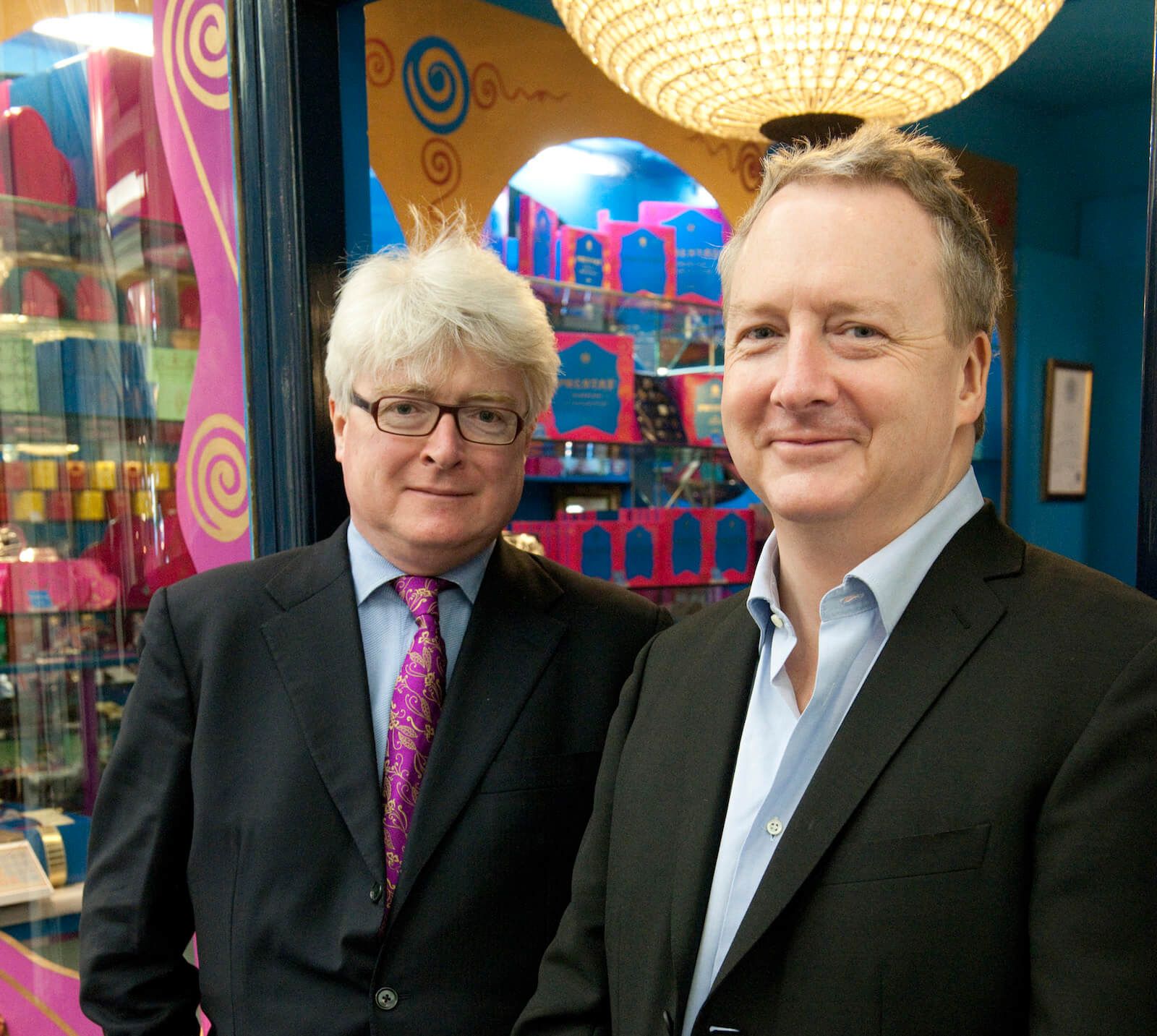Chocolate brand Prestat is famously delicious. It’s said to be the stuff that inspired famous author Roald Dahl to write Charlie and the Chocolate Factory. In fact, Dahl wrote his earlier work, My Uncle Oswald, all about the Prestat truffle giving it the reputation of a rather mischievous aphrodisiac.
Prestat’s legacy stretches back to 1902, when it was founded by French entrepreneur Antoine Dufour and his family as a ‘refreshment room’ in Oxford Street with a chocolate shop and kitchen. In 1958 Antoine’s son, Tony, sold the family business to brothers Maxwell and Neville Croft who ran it for many years. Inspired by their childhood memories, half-brothers Bill Keeling and Nick Crean acquired the famous brand in 1998 and breathed new life into it. Today the high-end chocolate brand is synonymous with colourful wrappings, royal warrants and a global presence. Prestat produces over 300 tonnes of chocolates and baked goods per year and has over the past 20 years grown its sales volume sixty fold. Tharawat Magazine spoke to Nick Crean about reviving a legacy and the recipe for a good family business.
What makes the Prestat story unique?
The Dufour family claim – and it’s never been disputed – that they invented the original recipe for the first chocolate truffle in Chambery in France in 1895. That recipe inspires everything we do today. We were awarded the Royal Warrant in 1975; being purveyors of chocolate to her Majesty the Queen is a rare acclaim. We were lucky enough to get a second Royal Warrant from the Queen Mother. There is a glorious eccentricity about Prestat, as well as an extraordinary quality.
When you bought Prestat did it have a well-documented history?
When we took the company on 20 years ago, people had forgotten the Prestat story. No one had bothered to apply for the Queen Mother Royal Warrant and the Roald Dahl story was there to be told, but no one had ever done so. In those days, we had very boring, brown packaging for our chocolates. But as soon as we started asking around, people came forward to say they remembered Prestat chocolate from their childhood and even the Dufour family who owned it in the 50s and 60s. We still hear from such people. In fact, it is what attracted me to Prestat in the first place: our own childhood memories.
We were lucky, snotty little children being brought up in Chelsea in the 60s. Sadly, my father had died in 1959. My mother remarried a wonderful man called Johnny Keeling, my half-brother Bill’s father. I used to get taken to Prestat as a treat before going to stay with aunts and uncles in the school holidays. I had this great memory of a mysterious but glorious chocolate shop with red velvet curtains and silver trays of truffles. What an adventure! When we talk about the brand now, we talk about it very much as something that is living history. After all, Prestat has been around since 1902, Bill and I are just custodians of this brand, and that’s what good brand owners should be. Machines die, people die, but what should live on is the brand, and the great ones do.

Why did you and Bill buy Prestat?
It was quite clear to us that Prestat was on the verge of collapse, and indeed, its sales, when we bought it, were a little under £100,000 a year. I was about 40, I had worked in advertising, I had been making brand spot films and documentaries, and I thought, “Here is something we could turn into our pension fund and have some fun doing it.” It felt like we were working towards a common goal; Bill and I make a wonderful team.
But I believe that having a family business doesn’t mean you should only have family members in it. My daughter, Ashley, is a very good ambassador for Prestat and often helps out but I think my children probably won’t follow in my footsteps. We’ve grown to a company> of about 80 people and they are all part of the family now. If you consider the families and children of those 80 employees, we’re probably responsible for 300 people in total. That gives you a sense of purpose.
[ms-protect-content id=”4069,4129″]
How do you retain talent?</strong>
The Royal Warrant certainly brings pride to our team</span>. We make the Queen’s Easter egg every year. These are things that all the employees can celebrate. When we get letters from the Palace, they always go on the any”>company notice board. When, eventually, William and Kate get a warrant, we will see a whole new generationpan> getting excited about it. Generally keeping people engaged and with the company is a matter of culture. Our manufacturingpan> is on the floor below and I go down there at least twice a day and have conversations with people. I am genuinely interested, and there is a strong sense of family.
When you took over how did you go about growing the businessn>?
One of the first things we did was to change the packaging. It had always been rather dull and brown. Our shop was all dark red velvet, and pretty gloomy too. We contacted a family friend called Kitty Arden who is an artist and designer, and with her, we came up with new colours for Prestat: pink, blue, and gold. The amazing thing was that, just by doing that, we saw a 30% increase in our sales almost immediately. It made people realise that Prestat was back. No one ever asked us to go back to brown!
Selfridges picked us up first, then Liberty’s, then we got the John Lewis partnership and then Waitrose. These were big stepping-stones in growing the brand. We also changed our chocolate supplier. We worked with different suppliers until we found our way to Marisu Petite Four who we’ve now acquired as our manufacturing arm. Their approach is highly innovative. We all work together to come up with the right recipes.

So I think a combination of clever packaging, a substantial investment in public relations, and working with interesting new recipes made by better chocolate makers, has helped accelerate a great rebrand. Twenty years ago we were turning over £100,000; the retail equivalent of what we are now turning over is about £7 million.
We sell all over the world: Australia, Japan, UAE, US. In fact, we like to say: “Somewhere in the world right now, someone is eating a Prestat chocolate.”
What are you planning for the future?
In a few years, Bill and I want to bring some more people on board. I think, alone, we are not necessarily the right people to take it on to the next stage of growth. I think we’re very much the right people to remain custodially involved and to be brand ambassadors but you need to bring in people who are better suited to innovating and selling the chocolates to another generation of consumers. Our ideas might be good, but we should always be balancing them out with the views of a generation or two after us. Our own children and godchildren will definitely be the kind of people we would want to talk to about future product development.
More and more businesses are doing that, and I think it’s very important in family businesses. Too often I sit on boards of other companies and when I look around I think, “I’ve got nothing against the people in this room, but why are some of them still here? You need to let go. You need to let some fresh air into this.” It goes both ways though, the next generation should also realise that there is a benefit in keeping the more experienced members involved in some capacity.
Can you tell us a little bit more about the chocolate industry?
The chocolate industry is strong but diverse sot it’s hard to identify unified trends. You have the low-end chocolate that is used for baking and ice cream and at the other end of the spectrum with gourmet chocolate such as Prestat. In between there are the huge chocolate makers, who we are all familiar with, who will continue to dominate the middle to lower end of the market. Household names vary greatly between the continents and you see many big food companies buying into those brands. You also have chef-led brands but they only have the shelf life of a chef’s career: you can go into their shops and buy a really delicious, imaginative truffle or bonbon, but you won’t be able to buy it anywhere else.
It’s an international game. We produce chocolates for all cultures. I see Prestat has the ability to be a brand which can develop, as we’ve begun to do, into cafés, jams, jellies, chocolate spreads and other high-end gifting products.

What advice would you give to young entrepreneurs wanting to grow their businesses?
You have to realise that you’re going to make a huge number of mistakes. You can call them mistakes or you can call them lessons, but building a business is a very difficult process to predict. People ask you to make three-year and five-year plans, but in many cases anything longer than a two-year plan is quite absurd. None of us can say what we will be doing in three years’ time, let alone after that.
Building relationships and your network is the most valuable thing you can possibly do. You absolutely must secure good relationships with your buyers, and that means making them feel part of your family and part of your culture.
Also really listen to others and always try new things. As a great Australian filmmaker called Philip Adams said, “If everyone is walking, why don’t you dance?” And if all else fails, just ask yourself “What would Willy Wonka do?”
[/ms-protect-content]














